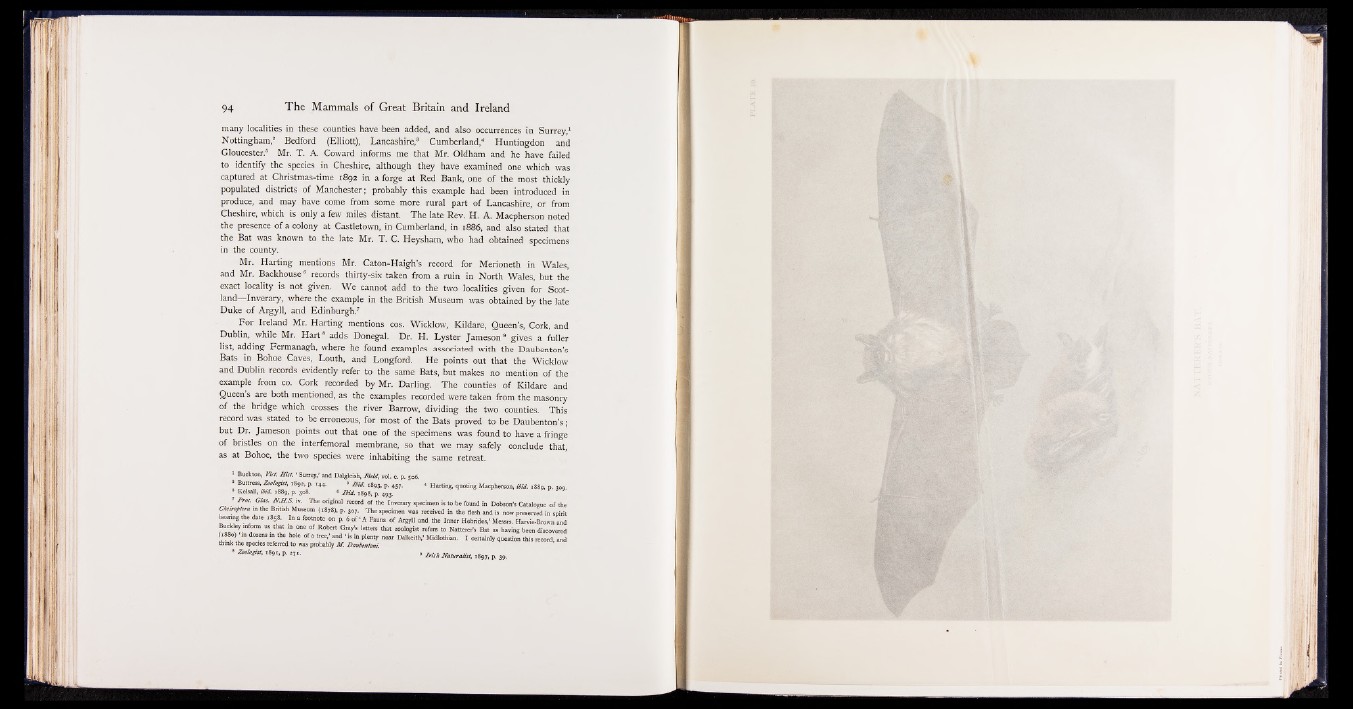
many localities in these counties have been added, and also occurrences in Surrey,1
Nottingham,2 Bedford (Elliott), Lancashire,8 Cumberland,4 Huntingdon and
Gloucester.5 Mr. T. A. Coward informs me that Mr. Oldham and he have failed
to identify the species in Cheshire, although they have examined one which was
captured at Christmas-time 1892 in a forge at Red Bank, one of the most thickly
populated districts of Manchester; probably this example had been introduced in
produce, and may have come from some more rural part of Lancashire, or from
Cheshire, which is only a few miles distant. The late Rev. H. A. Macpherson noted
the presence of a colony at Castletown, in Cumberland, in 1886, and also stated that
the Bat was known to the late Mr. T. C. Heysham, who had obtained specimens
in the county.
Mr. Harting mentions Mr. Caton-Haigh’s record for Merioneth in Wales,
and Mr. Backhouse6 records thirty-six taken from a ruin in North Wales, but the
exact locality is not given. We cannot add to the two localities given for Scotland
Inverary, where the example in the British Museum was obtained by the late
Duke of Argyll, and Edinburgh.7
For Ireland Mr. Harting mentions cos. Wicklow, Kildare, Queen’s, Cork, and
Dublin, while Mr. Hart8 adds Donegal. Dr. H. Lyster Jameson9 gives a fuller
list, adding Fermanagh, where he found examples associated with the Daubenton’s
Bats in Bohoe Caves, Louth, and Longford. He points out that the Wicklow
and Dublin records evidently refer to the same Bats, but makes no mention of the
example from co. Cork recorded by Mr. Darling. The counties of Kildare and
Queen s are both mentioned, as the examples recorded were taken from the masonry
of the bridge which crosses the river Barrow, dividing the two counties. This
record was stated to be erroneous, for most of the Bats proved to be Daubenton’s ;
but Dr. Jameson points out that one of the specimens was found to have a fringe
of bristles on the interfemoral membrane, so that we may safely conclude that,
as at Bohoe, the two species were inhabiting the same retreat.
1 Buckton, Viet. H ist. ‘ Sutrey,’ and Dalgleish, Field, vol. c. p. 506.
* Buttress, Zoologist, 1892, p. 144. « p> 45?_
1 Harting, quoting Macpherson, ibid. 1889, p. 309.
* Kelsall, ibid. 1889, p. 308. « Ibid. 1898, p. 493.
7 Proc. Glas. N .H .S. iv. The original record of the Inverary specimen is to be found in Dobson’s Catalogue of the
Cheiroptera m the British Museum (1878), p. 307. The specimen was received in the flesh and is now preserved in spirit
beanng the date 1858. In a footnote on p. 6 of ‘ A Fauna of Argyll and the Inner Hebrides,’ Messrs. Harvie-Brown and
Buckley inform us that in one of Robert Gray’s letters that zoologist refers to Natterer's Bat as having been discovered
H i d0ZenS “ thej hole of a tree-’ and ‘ is “ P^nty near Dalkeith,’ Midlothian. I certainly question this record, and
think the species referred to was probably M. Daubentoni.
9 Irish Naturalist, 1897, p. 39.